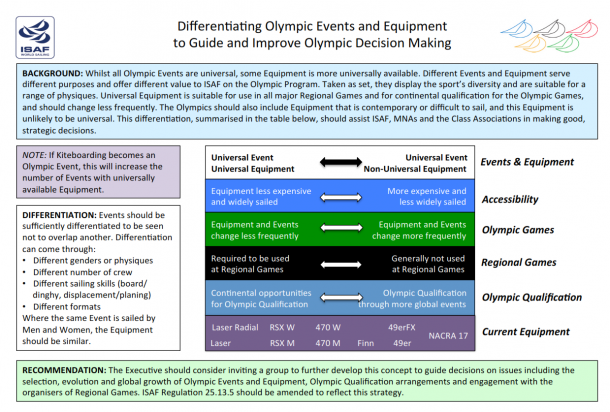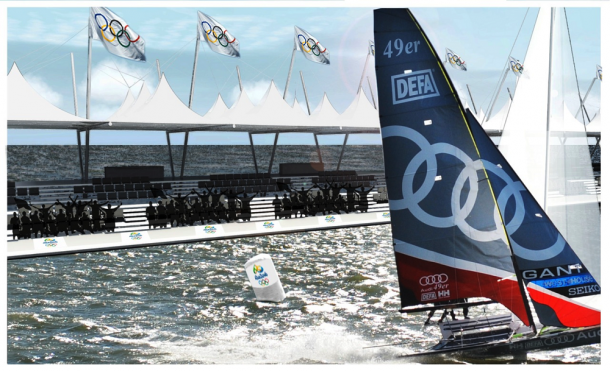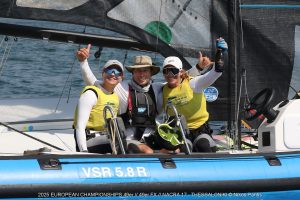Finals Day Format for 49er Racing
Olympic and World champions overwhelmingly support 3-race proposal
Objective
 To run three, single-point, 10 minute races in Theatre Style on Finals Day. This competition format adds value because it:
To run three, single-point, 10 minute races in Theatre Style on Finals Day. This competition format adds value because it:
- Displays to fans and broadcast media the intensity, skill and beauty of 49er sailing.
- Showcases the sport’s best sailors in live action and still photography.
- Promotes fair sailing, rewards consistency over the racing series, and crowns the best and most consistent sailors.
- Creates new potential revenue streams in fan admissions and increased broadcasts of major world events.
- Live broadcasting is the best business model for sports, and it is the basis of the business model for the Olympics.
- Live sporting events are valuable properties because they bring together fans to engage in an event at a specific time.
- ISAF wants to maximize the appeal of sailing at the Olympics to a live audience while offering the fairest sailing possible.
Assumptions
Theatre Style Complements the ISAF Agenda
Differentiation
ISAF’s own Olympic Commission report, states: “Events should be sufficiently differentiated to be seen not to overlap one another. Differentiation can come through: Different genders or physiques, Different number of crew, Different sailing skills (board/dinghy/displacement/planing), Different formats.” Therefore it is beneficial to sailing that events differentiate themselves. The 49er — and indeed, skiff sailing — culture always has put a premium on boat handling, with short course action being the norm. The 49er Class trials over the 18 months have proven the attraction of Theatre Style and its appropriateness for showcasing the sport to fans attending in person, watching on TV or streaming the broadcast.
- Page 2 of the 2013 ISAF Olympic Commission report.
Increasing Fairness
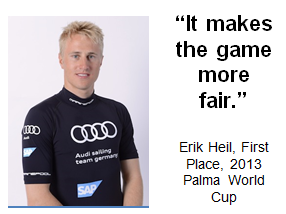 Independent statistical analysis and anecdotal accounts confirm that having three shorter races, instead of one longer race, increases the likelihood that the best sailors will win the regatta.
Independent statistical analysis and anecdotal accounts confirm that having three shorter races, instead of one longer race, increases the likelihood that the best sailors will win the regatta.
Experience with format trials over the last 18 months indicate that whatever format is used, it must embrace sailing’s long and rich history of rewarding consistency. Running multiple final races embraces and exceeds this objective.
Data scientist Christopher Ronnewinkel performed a statistical analysis of sailing in 2013 for one of the 49er class sponsors. Among his key findings: a shorter race is fairer than a longer race and less susceptible to random events. “When comparing the case of a single, long-race regatta with a three short-races regatta, we come to the following conclusions:
- For the same randomness, a single long-race regatta shows lower fairness then a three short-races regatta.
- A single long race encounters more random events and shows lower fairness than a single short race.”
His conclusion: “In total, a three short-races regatta will show higher fairness then a single long-race regatta.”
Class support: Top sailors want it
At the formal class Annual General Meeting, 87 percent voted in favor of three races and the Theatre Style format. A night earlier, at an open forum of all class members at the 2013 World Championship, a show of hands indicated 80 percent support of the membership.
Top Olympic sailors support the three single point races on Finals Day. See video testimonials from:
- Nathan Outteridge – Gold, London Olympics; 2009, 2010, 2011, 2012 49er World Champion, Helmsman Artemis, AC72
- Peter Burling & Blair Tuke – Silver, London Olympics; 2013 49er World Champion; Red Bull Youth Americas Cup winner
- Alex Maloney & Molly Meech – Gold, 2013 49erFX World Championship
- Allan Noregaard – Bronze, London Olympics
- Dylan Fletcher – Fourth place, 2013 49er World Championship
- Julien D’Ortoli – Sixth place, 2013 49er World Championship
- Erik Heil – First place, 2013 Palma World Cup
- Ida Nielsen – Gold, 2013 49erFX European Championship
- Jena Hansen – 49erFX vice president
Presentation
Three short single-point races run in Theatre Style produces the ultimate sailing showcase because:
- An app with cross-platform functionality provides broadcasters and fans with real-time race and overall regatta scores for every team

- The use of lane boundaries (typically 600m by 325m, but changeable based on wind conditions) will highlight strategy, tactics and rules because of the potential for boat-on-boat interaction, and generate more visual excitement for broadcast and fans.
- Lane boundaries will add value because fans will be able to get closer to the action by positioning their craft just outside the boundaries. In open course racing, it is not possible for fans or media to be anywhere near the sailors.
- The simple camera set-up will allow media to anticipate increased economies in crew deployment. Great coverage requires overhead cameras to tell the story of the race, camera boats to capture action, and onboard cameras to capture the emotions of the sailors. Theatre Style racing allows much simpler (and cheaper) camera set up for all three types:
- Overview — fixed onshore on high points, instead of helicopter.
- Camera boats – RIBS can get close, replacing gyrostabilizer yachts with zooms.
- Onboard the competition boats – a shorter course means more dependable signal transmission.
- A vibrant ringside concept can be encouraged – and possibly monetized — in Theatre Style. Specially designed (and transportable) barges or other craft can become the lane boundary, allowing fans to be close enough to feel the sailor’s emotion and energy. Equally, sailors will be encouraged to be at their best because they are able to hear the cheers of the crowd.
- Graphics will become more functional in the Theatre Style format. Using fixed camera positions, it becomes vastly easier and economical to overlay the types of graphics developed during the America’s Cup. These analytic overlay graphics are essential to helping the non-sailing public understand our sport. “A single long lens, tripod-mounted camera can cover the entire course; it does not require a helicopter to overlay the types of graphics,” says Stan Honey, creator of the 2013 America’s Cup graphics.
- The fan experience is enhanced because fans get six (each 49er and 49erFX) short Theatre Style races, instead of two 20-minute medal races.
- Broadcast time is extended because the Theatre Style format provides for 10-minute races with a break while fleets switch from 49er to 49erFX.
Race Management
Running three Theatre Style races is not more complicated than one, double-point race. The Class has worked to streamline and make more efficient all aspects of race management. Particularly:
Course Setup/Boundary Ropes – Race officials can manage the lane ropes in any situation without a negative impact on the regatta. Here is a video of how it’s done. If conditions are unsuitable, race officials may simply remove the lane ropes and run normal racing. Based on experience using the lanes, the 49er Class can offer guidelines on when the lane ropes should be removed. Setting up the boundary ropes is simple and economical. For the proposed 49er and 49erFX course, the cost is roughly USD$500 in reusable buoys and lane rope. Two 600m boundaries can be prepared in approximately 30 minutes by two RIBS with two crew members.
Race officials run theatre races much like normal races and no specialized skills are required to enact the theatre. There are some subtle changes that are needed and they are outlined in the Race Officials guidelines.
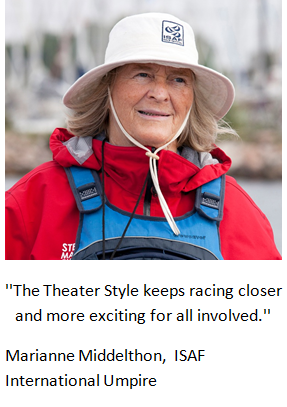 Umpire Playbook – The 49er Class has been working with umpires Doug Sloan[viii], Bill O’Hara, Marianne Middelthon, and others to develop an umpiring playbook for Theatre Style. This is based on Addendum Q, an ISAF document designed to ensure results are final as the boats cross the finishing line, using on-the-water umpires who give immediate decisions to any protest between boats. The document is kept updated by ISAF so that racing always follows the most recent ideas.
Umpire Playbook – The 49er Class has been working with umpires Doug Sloan[viii], Bill O’Hara, Marianne Middelthon, and others to develop an umpiring playbook for Theatre Style. This is based on Addendum Q, an ISAF document designed to ensure results are final as the boats cross the finishing line, using on-the-water umpires who give immediate decisions to any protest between boats. The document is kept updated by ISAF so that racing always follows the most recent ideas.
The Theater Style with its enclosed area provide for action packed sailing, where boat handling and tactics play an important role. This leads to more situations where the racing rules of sailing are pushed to its limits. 3 or 4 small ribs follow the 49ers closely around the course. Each boat has 2 umpires onboard, focussing on the action, anticipating pressure points and looking after the fairness of the competition on the spot. No additional expertise is required, although experience in the Theatre Style format is helpful.
References
Some great theatre style series have already been filmed. Here are three playlists from Theatre Style Finals of 49er events:
[viii] Dear ISAF Officials,
As an IU and IJ who has umpired many medal races, I find the difference between the 49’er style theatre style medal racing vs traditional medal style racing to be dramatic. First and most importantly, the theater style medal racing format is MUCH more exciting to the competitors. The fast action, constant interaction of boats (ahead and behind), the necessity of attention to wind shifts, boat trim, sail trim, as well as boat-on-boat tactics makes for much more exciting racing. The eventual winner will be the best rounded racer, not just one with a limited set of skills. Secondarily, the spectators find the theatre style racing MUCH more entertaining. The crowds I have observed watching the theatre style racing have been 10-20 times greater than those watching the traditional medal races. Lastly, the umpiring of theatre style racing is much more exciting than what is required for a traditional medal race.
I highly recommend theatre style medal races for the 49’er and FX class over the traditional single medal race.
Sincerely,
L. Douglas Sloan


